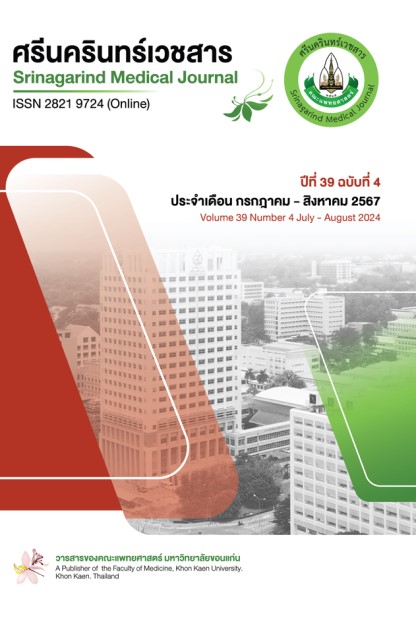Study of Diagnostic Reference Levels Undergoing Digital Chest Radiography at Queen Sirikit Heart Center of the Northeastern, Faculty of Medicine, Khon Kaen University
Keywords:
Digital chest radiography, Entrance Surface Air Kerma dose (ESAK), Diagnostic Reference Levels (DRLs), Chest radiographyAbstract
Background and objectives: The study aimed to estimate the entrance surface air kerma (ESAK) received by patients during digital chest radiography, establishing typical reference radiation values by comparing the diagnostic reference levels with national (national diagnostic reference levels, NDRLs). The objective was to Radiological technologist to use appropriate radiation doses, ensuring that the levels are neither too high nor too low, while maintaining diagnostic image quality. This also serves as a guideline for reducing radiation doses in chest radiography.
Methods: The study measured the entrance surface air kerma (ESAK) received by patients during Chest PA Upright radiography and portable AP supine radiography using the digital imaging system for patients at the Department of Diagnostic Radiology, Queen Sirikit Heart Center of the Northeast, Faculty of Medicine, Khon Kaen University. The median value of ESAK was calculated to establish typical reference radiation values.
Results: The study found that the typical reference radiation value using the median ESAK for chest PA upright radiography was 0.30 mGy, and for Portable AP Supine radiography was 0.19 mGy. When comparing these values with national (NDRLs) using the 75th percentile, it was found that the diagnostic reference level for chest PA upright radiography was lower than the national level (0.40 mGy). For portable AP supine radiography, the diagnostic reference level was lower than the national level (0.34 mGy ).
Conclusion: The technical settings for radiation doses in chest radiography are appropriate, ensuring that patients do not receive surface radiation doses exceeding standard levels.
References
Samei E, Hill JG, Frey GD, Southgate WM, Mah E, Delong D. Evaluation of a flat panel digital radiographic system for low-dose portable imaging of neonates. Med Phys 2003 ;30(4):601-7. doi:10.1118/1.1556611.
International Commission on Radiological Protection. Diagnostic Reference Level in Medical Imaging. ICRP Publication 135. New York: ICRP, 2017.
International basic safety standards for protection against ionizing radiation and for the safety of radiation sources: safety series no. 115. Vienna, Austria: IAEA, 1996.
Singkawongzai A, Tupawat S. (Eds.) . National Diagnostic Reference levels in Thailand. 1st. Bangkok: Beyond Publisher, 2023.
International Atomic Energy Agency. Dosimetry in diagnostic radiation: an international code of practice, tech-nical report series no. 457. Vienna: International Atomic Energy Agency, 2007.
International Atomic Energy Agency. Handbook of Basic Quality Control Tests for Diagnostic Radiology: IAEA Human Health Series No. 47. Vienna: International Atomic Energy Agency, 2023.
Downloads
Published
How to Cite
Issue
Section
License
Copyright (c) 2024 Srinagarind Medical Journal

This work is licensed under a Creative Commons Attribution-NonCommercial-NoDerivatives 4.0 International License.




